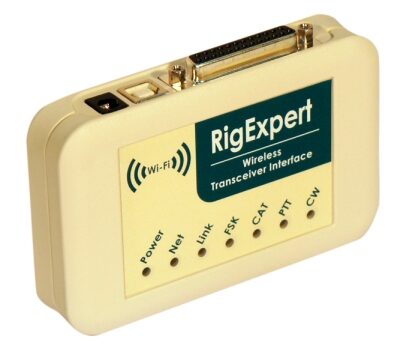Connect your transceiver to the Internet via a Wi-Fi network. Use your laptop to operate phone, CW or digital modes from anywhere in the world!
RigExpert WTI-1 is a revolutionary new device to interface your transceiver to your computer wirelessly. It provides:
Transceiver audio interface
Analog audio interface is a connection to transceiver audio output (external speaker connector or line output) and transceiver audio input (microphone connector or line input). Audio interface enables operating digital modes, recording and playing voice, as well as other useful functions (such as measuring levels of a signal from the air) by using a computer.
You may use a conventional headset on your computer to operate voice modes. A virtual sound card drives is provided to support operating digital modes.
CAT interface for various transceiver models
CAT (Computer Aided Transceiver) system provides control of transceiver frequency, operating mode and other functions by computer software. Normally, modern transceivers have serial (with various signal levels) link providing CAT interface.
In RigExpert WTI-1, CAT interface port is seen as a COM port by computer software.
http://youtu.be/wyIUOqVFxVU
FSK output
FSK (Frequency Shift Keying) is a popular method of transmitting digital messages over radio primarily used in radioteletype (RTTY) mode. Most transceivers provide FSK modulator feature to make the RTTY signal stable and clear.
A separate COM port is assigned for the FSK output when using RigExpert WTI-1.
PTT and CW output functions
Transceivers provide PTT (Push To Talk) and CW (Continuous Wave) keyer inputs to allow setting the transmitter on or off and operating CW using external device (PTT pedal, CW bug or paddle, terminal node controller, or personal computer).
In RigExpert WTI-1, PTT and CW outputs are assigned to the RTS and DTR lines of a separate COM port. In addition, the user may press the PTT button on the screen to activate transmission.
WinKey emulation
To operate CW, you may use software which either directly manipulates the DTR line, or uses the WinKey protocol.
A separate COM port is created in the system to support the WinKey data exchange.
Price: TBD

